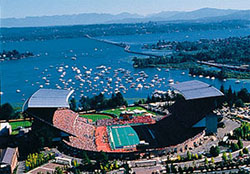Imagine a one-stop planning station for your morning commute where you could park your car or lock up your bike; get a cup of coffee; check current traffic conditions; buy a transit pass or Good To Go! tolling transponder; charge your electric vehicle; then board a bus or meet a ride-share partner or vanpool.
Already, commuters are using NewMobility Hubs in cities around the world, including Hong Kong, Rio de Janeiro and Bremen, Germany. Some hubs incorporate showers for cyclists and bikes to share, telework centers, workforce housing and mixed-use retail to help support sustainable communities. It’s an emerging technology that manages traffic by offering convenient access to information, transportation options and amenities.
For Washington State, it’s the future of traffic management and a sustainable transportation network that reduces harmful carbon emissions by supporting the use of alternative-fuel vehicles, transit and ride-sharing.
Rebooting an important high-tech corridor
WSDOT plans to locate the state’s first NewMobility Hub at one of several possible sites in central Puget Sound along a corridor that serves one of the most advanced high-tech industry centers in the world – State Route 520. While SR 520 may be a magnet for innovators of computer technology, it contends with ever-increasing traffic congestion, an aging bridge across Lake Washington that must be replaced and the necessity of electronic tolling, which begins spring 2011.
For many SR 520 commuters, the hub will be a daily first stop to choose the best way to cross the lake. They’ll see the current traffic situation and toll rate at an electronic kiosk; then decide whether to drive, take a bus or log onto RideshareOnline.com to find an instant ride match for a faster trip across the lake in the carpool lane.
NewMobility Hubs Offer
- Real-time traffic information
- Real-time transit information
- Carpool, vanpool and bike-buddy matching via RieshareOnline.com
- Electric vehicle charging stations
- Good to Go! electronic tolling and ORCA transit card purchase kiosks
- Bicycle storage, trail maps, transit information for cyclists
The hub will be just one of multiple new high-tech tools for commuters on SR 520. By late this summer Smarter Highways technology will begin providing better traffic information than ever on electronic signs mounted over the roadway. Nineteen separate sign locations between I-5 in Seattle and 130th Ave NE in Bellevue also will support electronic variable-speed-limit and lane-status signs that smooth traffic flow and reduce collisions and the jams they create.
Partnership
NewMobility Hubs provide a unique public/private partnership opportunity among government agencies and the private sector. WSDOT is teaming up with partners like Microsoft, Inrix, Ford, Cascadia, University of Washington and others to develop a network of NewMobility Hubs.
Enhance Transit
The NewMobility Hub will enhance transit-oriented development features such as telework centers, workforce housing, and mixed use retail to help support sustainable communities. A network of NewMobility Hubs would benefit the region by:
- helping travelers make decisions based on real-time traffic and transit information.
- expanding green commute options.
- encouraging the use of electric cars and shared vehicle programs such as Zipcar.
- supporting the West Coast Green Highway Initiative.
- creating green jobs and providing workforce development to prepare workers for high tech jobs.
- helping meet greenhouse gas reduction goals and advancing energy independence.
WSDOT is seeking grant funding to help create a network of NewMobility Hubs including the “UDub Hub” at Seattle’s Husky Stadium. Washington plans to expand the NewMobility network throughout other major urban areas. Eventually the network of NewMobility Hubs would connect to the Tacoma Dome along the I-5 Corridor.
